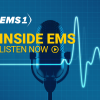In this episode of the Inside EMS Podcast, cohosts Chris Cebollero and Kelly Grayson discuss Orange County, Florida’s adoption of live stream technology for 911 calls, a move that promises to enhance the quality of emergency response through better triage and patient care.
This episode of Inside EMS Podcast exemplifies the ongoing evolution of emergency medical services, marked by technological innovation, educational advancements, and the importance of leadership and community engagement in shaping the future of EMS.
Learn more: Fla. county launches livestream option for 911 calls
Cebollero and Grayson discussed how integrating video technology into 911 dispatch can improve EMS response in the following ways:
- Enhanced triage accuracy. Live streaming allows dispatchers to visually assess the situation, leading to more accurate triage and resource allocation. This visual context can be crucial in determining the urgency and nature of the response needed. By providing dispatchers with a live visual feed, EMS teams can be better prepared upon arrival, knowing what to expect and potentially improving patient outcomes.
- Supporting scene safety. Live streaming video in 911 dispatch can significantly improve scene safety for emergency medical personnel by providing real-time visuals of the incident site before their arrival. This advanced insight allows paramedics and EMTs to assess potential hazards, understand the severity of the situation, and prepare appropriate safety measures in advance. This technology empowers responders with crucial information, enabling them to make informed decisions about their approach and ensuring they can protect themselves effectively while delivering critical care.
- Improved dispatcher-patient interaction: The ability to see the caller and the scene in real-time enhances communication between dispatchers and those in need, fostering a more empathetic and effective exchange of information.
- Efficiency in emergency response. Visual cues obtained through live streaming can help in quickly identifying the nature of the emergency, potentially reducing response times and increasing the chances of a positive outcome.
- Enhanced training opportunities. Recorded live streams can serve as valuable training tools, offering real-life scenarios for emergency responders and dispatchers to learn from and improve their skills.
- Cross-agency collaboration. The integration of live streaming technology encourages collaboration between EMS, fire departments, police and other emergency services, enabling a more coordinated response to incidents.
While enthusiastic about the potential of new technologies, Cebollero and Grayson also discussed the need for caution and the anticipation of unforeseen challenges, particularly concerning the privacy and security of live streamed 911 calls.
Also in this episode
- Innovations in EMS. Chris Cebollero shared his new role with QuickMedic and their innovative approach to utilizing paramedics for urgent care in collaboration with healthcare partners, indicating a shift towards more versatile roles for EMS professionals. He emphasized the importance of leadership and vision in developing effective teams across multiple states.
- Education and training. Kelly Grayson shared experiences from teaching a new accelerated paramedic program, stressing the importance of rigorous standards and personalized feedback to ensure student success, highlighting the evolving educational methodologies in EMS training.
About the sponsor
This episode of the Inside EMS Podcast is sponsored by LogRx. Learn a better way to track your narcotics at .
SA���ʴ�ý is using generative AI to create some content that is edited and fact-checked by our editors.


